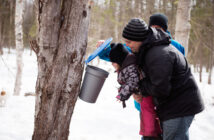Hey mamas, did you know drowning is the number one cause of injury-related death for children ages one to four and kills nearly 1,000 children every year? With summer on the horizon, and kids spending more time around water, water safety is of the utmost importance. May is National Water Safety Month and Goldfish Swim School is making parents aware of things they can do so kids have a safe and happy experience in and around water. Read on to find out how the Goldfish Swim School strives to reduce childhood drownings through classes, swimming education, and the “Safer Swimmer Pledge.”
Become an NJMOM Insider! For all the best things to do with your family around New Jersey, be sure to sign up for our weekly newsletter delivered right to your inbox each week, and don’t forget to tag your photos #NJMOM and @njmom for a chance to be featured on our social media.

Interesting fact: Formal swim lessons can reduce drownings by 88%.
Why water safety is more crucial than ever
According to Total Aquatics Programming data, May through August accounts for two-thirds of annual childhood drowning incidents. Sadly, childhood drownings have been on the rise as the American Academy of Pediatrics issued a formal warning of an increased threat in drownings because kids haven’t been able to partake in swim lessons in over a year due to the pandemic. While these statistics can be frightening, the good news is that parents can do plenty of things to keep their kids safe in and around water. As we head to pool and beach season, it’s the perfect time for all families and caregivers to review essential swim and water safety basics.
5 tips for water safety from Goldfish Swim School
Did you know that formal swimming lessons reduce the likelihood of childhood drowning by 88 percent? We asked the swim and water safety experts at Goldfish Swim School to share their essential water safety tips with us, and this is what we learned—enrolling in swim lessons can be a lifesaver. As a result of the increased threat of childhood drownings, the American Academy of Pediatrics recommends that kids continue to participate in organized drowning prevention classes. Lessons help increase muscle memory by practicing essential techniques for kids to use during a water emergency—such as the crab walk, properly getting in and out of the pool, going underwater, rolling on their back, treading water, learning different strokes, and breathing.
And one tip we all should keep in mind—never swim alone. While many kids think they’re all grown up and don’t need a swim buddy, you can re-enforce this rule by explaining this rule goes for kids and adults alike. Teach your children to always have a buddy in the water—whether it be an adult or peer—at the beach, on vacation, or at home. Children can drown in as little as two inches of water, so if water is around, make sure someone else is, too.

Goldfish Swim offers lessons for all ages.
If you haven’t already, make sure you invest in a U.S. Coast Guard-approved life jacket. Having a suitable floatation device is one of the easiest ways to increase safety in the water—search for the United States Coast Guard approval on it. Pay attention to proper fit—the fit matters because if your head or ears can slip down beneath the life jacket, the device won’t be able to work as designed to keep your head above water and allow for proper breathing. A U.S. Coast Guard-approved life jacket is essential when swimming in lakes and oceans when water conditions can be uncertain and unpredictable.
Another way to keep an eye on kids? Designate a water guardian, even if lifeguards are present. Kids are as curious as they come and are always willing to push the limits without knowing the true hazards. Designate an adult “Water Guardian” and be sure to change guardians every 30 minutes, so he/she is alert and refreshed. A Water Guardian’s sole responsibility needs to be keeping an eye on the swimmers. Vigilance is key—no chatting, no checking your phone, no distractions.
At last, play it cool and follow the rules. Sometimes when kids are in play mode, rules fall by the wayside. Review rules together as a family before letting your kids loose to enjoy the water. Pay special attention to pool hours, and always schedule your swims when lifeguards are present, if possible.

Take the Safer Swimmer Pledge with Goldfish Swim School
Goldfish Swim School has launched a ‘Safer Swimmer Pledge’ campaign to bring greater awareness to water safety and drowning prevention. Throughout May, families are encouraged to take the pledge and promote the importance of parent-child conversations around water safety. By visiting the Safer Swimmer Pledge landing page, families can sign to join the cause in promoting and prioritizing water safety while also accessing at-home water safety tools and activities and reviewing “water safety whys”—families first-hand experiences and testimonials on how water safety has made an impact in their lives. Those who take the pledge will be entered to win one year of free swim lessons at Goldfish Swim School. Additionally, for each pledge, Goldfish Swim School will donate $1 to the USA Swimming Foundation, the philanthropic arm of USA Swimming, which supports swim lesson providers with resources, materials, and grant funding to allow the opportunity for every child across the country to learn to swim. Once families have taken the pledge, they will also receive a promo code for 25% off any Speedo USA purchase, with 10% of that purchase also donated to the USA Swimming Foundation.
Goldfish Swim School provides swim instruction to children ages 4 months to 12 years in a family-friendly setting with highly trained instructors, small class sizes, shiver-free 90-degree pools. Goldfish Swim School has locations in Closter, Denville, Livingston, Manalapan, Middletown, and Wyckoff. Visit the website for more information: goldfishswimschool.com.
Psst—want to read more posts like this? Sign up for NJMOM’s weekly newsletter, follow us on Instagram and Facebook, and use #NJMOM on all your adventures around New Jersey.
This post is sponsored by Goldfish Swim School, pledging to make all #NJMOMs and their families safer, informed swimmers.







